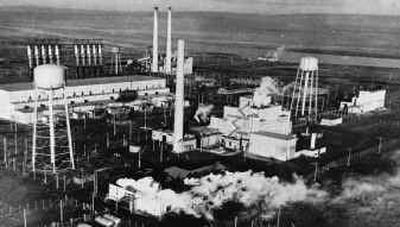Hanford reactor to be put on historic property list

YAKIMA – Former nuclear workers and concerned residents in south-central Washington for years have been trying to preserve the world’s first full-scale plutonium production nuclear reactor – Hanford’s B Reactor – as a museum.
Their efforts were expected to receive a boost today when the Washington Trust for Historic Preservation planned to name the B Reactor to the 2004 Most Endangered Historic Properties list.
“It’s of unparalleled historical significance. The B Reactor is unlike any other historical resource we have, not only in the state of Washington, but in the rest of the country as well,” said Lisbeth Cort, executive director of the Washington Trust, a statewide, nonprofit historic preservation group.
Just yards from the Columbia River, B Reactor produced the plutonium for the first man-made nuclear blast, the Trinity test in New Mexico on July 16, 1945. The reactor also produced the plutonium for the bomb that was dropped on Nagasaki, Japan, in World War II that August.
It was the world’s first large-scale nuclear reactor, built as part of the top-secret Manhattan Project. Construction began June 7, 1943, just six months after physicist Enrico Fermi turned the theory of nuclear power into the reality of the Atomic Age.
The reactor has been placed on the National Register of Historic Places, but its future has remained in doubt as cleanup progresses at the Hanford site.
For more than a decade, efforts have been made to turn the old reactor into a museum. Bills under consideration in Congress would direct the secretary of the interior to study the potential for developing B Reactor and other key Manhattan Project facilities as historical sites.
The other eight Hanford reactors are expected to be cocooned, which involves removing extra buildings around the reactors and demolishing all but the shield walls surrounding the reactor cores and sealing them in concrete.
A decision on the future of B Reactor isn’t due until 2006.
“We’re at a really important crossroads for the B Reactor,” Cort said. “Whether it will be cocooned like C Reactor and other parts of the Hanford site, or whether there’s a possibility in the future for it to be opened to the public and interpreted – it’s a real critical time.”
Del Ballard, president of the B Reactor Museum Association and a retired civil engineer who worked at the Hanford site for 42 years, praised any efforts to bring attention to the B Reactor and the role it played in World War II.
“I just want to see it preserved so that future generations can learn history,” Ballard said.
B Reactor was shut down in 1968 and decommissioned. While some parts of the reactor are sealed off because they are radioactive, the control room and the face of the reactor, where fuel rods were inserted, can today be viewed safely.
The reactor has been open for limited historic tours since the mid-1980s, but those were slowed by the 2001 terrorist attacks. The Energy Department, which manages cleanup at the site, still allows tours for groups interested in historic preservation.
“We would love to see an organization step up to operate the B Reactor as a museum because it has a unique history, but we just can’t take on that project,” said Andrea Harper, spokeswoman for the Energy Department’s Richland office.
The B Reactor was one of eight sites on the 2004 list, which also listed “endangered” properties in Everett, Ellensburg, Port Townsend, Winlock, and Columbia and Whatcom counties.
Since 1992, the Washington Trust for Historic Preservation has published a Most Endangered Historic Properties List to bring attention to threatened sites. The sites are nominated by concerned citizens and organizations across the state.